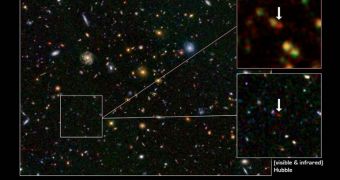An extremely old, blob-shaped galaxy was recently demonstrated to be producing young, blue stars at a frantic pace, say astronomers with the science team. They used the NASA Hubble Space Telescope and the Spitzer Space Telescope to image the object in visible-light and infrared wavelengths.
This particular galaxy – which is known among astronomers as GN-108036 – is one of the most distant ever discovered, appearing as a faint red dot in telescope data. According to previous studies, the object is located about 12.9 billion light-years away.
What this implies is that the galaxy began developing just 850 million years after the Big Bang. Thus far, none of the other galaxies determined to have begun appearing around that time revealed such high rates of stellar formation, the group explains.
Both Hubble and Spitzer revealed that as many as 100 new Suns appear inside GN-108036 every year - which is 30 times higher than the Milky Way's own rate. At the same time, our galaxy is roughly five times larger than its ancient counterpart, and contains 100 times more matter.
The Mauna Kea, Hawaii-based Subaru Telescope was the first to discover the object, during a study conducted by a team of Japanese investigators at the University of Tokyo. The group was led by expert Masami Ouchi, who was also the leader of the recent international study.
The W.M. Keck Observatory was then used to accurately measure the distance the red blob was from Earth. “The discovery is surprising because previous surveys had not found galaxies this bright so early in the history of the Universe,” Mark Dickinson explains.
“Perhaps those surveys were just too small to find galaxies like GN-108036. It may be a special, rare object that we just happened to catch during an extreme burst of star formation,” adds the expert, who holds an appointment with the National Optical Astronomy Observatory (NAOA), in Tucson, Arizona.
“We checked our results on three different occasions over two years, and each time confirmed the previous measurement,” University of Tokyo professor and lead study author Yoshiaki Ono says. The paper appears in a recent issue of the Astrophysical Journal.
The main implication of finding such intense stellar formation in such an old galaxy is that the formation accumulated mass in very high volumes during the earliest stages of its life. At that time, the entire Universe was only 5 percent of its current age.
“This was therefore a likely ancestor of massive and evolved galaxies seen today,” concludes University of California in Riverside (UCR) scientist and team member Bahram Mobasher.

 14 DAY TRIAL //
14 DAY TRIAL //